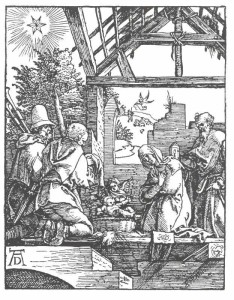by Rev. James Lee

As Lutherans, when we speak about the person and work of Jesus of Nazareth, we often concentrate on His passion—His suffering and death—and resurrection. Jesus dying in our stead and rising to life from the grave: these are the center of the Church’s proclamation of justification. Yet, in our focus on Jesus’ salvific works, we must always remember that the heart of the person and work of the Messiah stands the incarnation. Our Christian faith is founded upon the personal union of the divine and human nature realized in the son of Mary.
Martin Chemnitz (1522–1586), the great theologian of the second-generation of Lutheran reformers, helps us understand that in order to properly appreciate, confess, and adore the saving work of Christ, we must begin with our Lord’s incarnation:
“This union [of divine and human natures] took place for us men and for our salvation and was directed toward the work of redemption and the rule and priesthood of the Messiah. For since the redemption had to take place through the suffering and death, the human nature was necessary. And since the serpent’s head had to be crushed by divine power through death, the divine nature was also necessary in the person of the Redeemer. It pleased God that for our comfort our assumed nature might be employed for the work of the kingship, the priesthood, and the lordship of Christ . . .”[1]
Chemnitz’s words seem like an answer to the old question that theologians, following the great St. Anselm of Canterbury (1033–1109), often ask when discussing the work of Christ: Cur Deus Homo—Why did God become man? God became man for the redemption of humanity. In the person of Jesus God united Himself in order to die our death, to trample down death, and to give us new life in Him. Chemntiz reminds us that in order to understand the crucifix and the empty tomb, we must return to the Annunciation, and the nativity, for the work of redemption is undertaken by the One who is truly God and truly man. Conversely, Chemnitz would not have us gaze upon the nativity scene apart from the crucifix, for this is why Jesus is born: to die on the cross, to rise from the dead, to ascend to His Father’s right hand, and to send the Holy Spirit upon His Church.
The doctrine of the incarnation grounds our Christian faith and helps us understand the mystery of the person and work of the Son of God. The incarnation presents Christians a source of comfort and hope for our life in the Church, for we are reminded that not only is God with us, but also He is with us as one of us. Again, Chemntiz aids us in appreciating this joy:
“For He wishes to be present also in and with His assumed nature by which He is of the same substance with us, related to us, our Brother, our very flesh, according to which flesh He does not blush to call us His brothers and in which flesh He was tempted, so that He can share in our sufferings, according to which flesh Christ is our Head and we are His members. And just as no one hates his own flesh, but nourishes and cherishes it, so also Christ does to His church, since we are members of His body, of His flesh and of his bone (Eph. 5:29).”[2]
The Son of God is also the Son of Mary. Through the incarnation the Son of God shares in our life, our trials and sufferings, even our death. Similarly, as the Son of God shares our life, Jesus invites us into His life. This is the life of the Church, being a member of the body of Christ. The incarnation opens our eyes to see the fullness of the name Immanuel—God with us, as one of us, in Jesus. The incarnation teaches us that the Son of God comes to be like us, to die for us, so that we might live with Him.
The Rev. James Ambrose Lee II is the assistant pastor of Trinity Lutheran Church, Worden, IL and doctoral candidate at Saint Louis University.
[1] Martin Chemntiz, The Two Natures in Christ, trans. J. A. O. Preus (St. Louis: Concordia Publishing House, 1971), 71.
[2] Chemntiz, The Two Natures in Christ, 435.